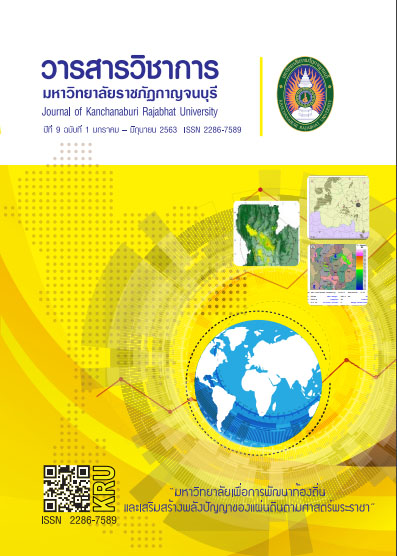THE EFFECTS OF 4 MAT MODEL LEARNING ACTIVITIES MANAGEMENT IN THE TOPIC OF FOUNDATION OF GEOMETRY ON MATHEMATICS LEARNING ACHIEVEMENT AND ATTITUDE TOWARDS MATHEMATICS LEARNING OF MATTHAYOM SUKSA I STUDENTS AT TESSABAN 3 (SRAKRATIEM) SCHOOL IN NAKHON PATHOM PROVINCE
Main Article Content
Abstract
This research aimed (1) to compare Mathematics achievement on Basic Geometry between two groups of Mathayom Suksa 1 students: one group received 4 MAT learning activities while the other received traditional learning activities, and (2) to understand attitude of the students who received 4 MAT learning activities towards Mathematics on Basic Geometry in Mathayom Suksa 1 at Tessaban 3 (Srakratiem) school in Nakhon Pathom province. Research instruments comprised: (1) a learning management plan of Basic Geometry with 4 MAT learning activities, (2) a learning management plan of Basic Geometry with traditional learning activities, (3) Mathematics achievement test of Basic Geometry with a content validity of 0.90, the difficulty (p) ranging 0.27 - 0.77, the discrimination (r) ranging 0.33 - 0.67 and the reliability was 0.93, and (4) attitude survey towards studying Mathematics with construct validity in average of 4.67 and standard deviation of 0.39, showing that the attitude survey was the most suitable with the discrimination (r) ranging 0.57 – 0.89 and reliability was 0.93. Statistics for data analysis included average, standard deviation and t-test. Findings revealed that (1) Mathematics achievement on Basic Geometry of students receiving 4 MAT learning activities was statistically higher than that of students receiving traditional learning activities, at significant level of .05 and (2) students receiving 4 MAT learning activities had attitude towards 4 MAT based learning Mathematics overall at the high level (= 4.45, S.D. = 0.66), considering each aspect ordered from the highest to the lowest as follows: at the highest level for knowledge, at a high level for feeling, and at a high level for behavior respectively.
Article Details
References
จารุวรรณ สิงห์ม่วง และสุทิวัส โคตะมะ. (2561). การพัฒนาผลสัมฤทธิ์ทางการเรียนคณิตศาสตร์ เรื่อง การแก้โจทย์ปัญหาอัตราส่วนและร้อยละ สำหรับนักเรียนชั้นมัธยมศึกษาปีที่ 2 โดยใช้แบบฝึกทักษะ. วารสารวิชาการมหาวิทยาลัยราชภัฏกาญจนบุรี, 7(1), 69-75.
เธียร พานิช. (2544). 4 MAT การจัดกจิกรรมการเรียนการสอนให้สอดคล้องกับธรรมชาติการเรียนรู้ของผู้เรียน.กรุงเทพฯ : มูลนิธิสดศรี-สฤษดิ์วงศ
นพมาศ ธีรเวคนิ. (2542). จิตวิทยาสังคมกับชีวิต (พิมพ์ครั้งที่3). กรุงเทพฯ: มหาวิทยาลัยธรรมศาสตร์.
บุญถม วรรณทอง. (2555). การพัฒนากิจกรรมการเรียนรู้คณิตศาสตร์ เรื่อง อสมการ ชั้นมัธยมศึกษาปีที่ 3 โดยใช้รูปแบบการเรียนรู้แบบ 4 MAT. วิทยานิพนธ์ปริญญาศึกษาศาสตรมหาบัณฑิต สาขาวิชาหลักสูตรและการสอนบัณฑิตศึกษา คณะศึกษาศาสตร์ มหาวิทยาลัยขอนแก่น.
พรพิไร แก้วสมบัติ. (2551). การพัฒนาผลการเรียนรู้ เรื่อง การแปลงทางเรขาคณิต ของนักเรียนชั้นมัธยมศึกษา ปีที่ 2 ที่จัดการเรียนรู้แบบ 4 MAT. วิทยานิพนธ์ปริญญาศึกษาศาสตรมหาบัณฑิต สาขาวิชาหลักสูตรและการนิเทศ ภาควิชาการหลักสูตรและวิธีสอน คณะศึกษาศาสตร์ มหาวิทยาลัยศิลปากร.
สุภาวดี หัดที. (2553). ผลการจัดกิจกรรมการเรียนรู้คณิตศาสตร์ โดยใช้วัฏจักรการเรียนรู้แบบ 4 MAT เรื่อง ระบบสมการเชิงเส้น ชั้นมัธยมศึกษาปีที่ 3. วิทยานิพนธ์ปริญญาครุศาสตรมหาบัณฑิต สาขาคณิตศาสตร์ศึกษา คณะครุศาสตร์ มหาวิทยาลัยราชภัฏมหาสารคาม.
อัชมา มาลินี. (2557). การพัฒนาชุดการเรียนคณิตศาสตร์ตามวัฏจักรการเรียนรู้ 4 MAT โดยใช้โปรแกรม The Geometer’s Sketchpad เรื่อง การแปลงทางเรขาคณิต ระดับชั้นมัธยมศึกษาปีที่ 2.. วิทยานิพนธ์ปริญญาวิทยาศาสตรมหาบัณฑิต สาขาวิชาคณิตศาสตร์ศึกษา คณะวิทยาศาสตร์ มหาวิทยาลัยบูรพา.
David A. Kolb. (1984). Experiential Lerning. New Jersey: A Simon & Schuster Company.
Jackson, Phillip R. (2004). The Effects of Teaching Methods and 4 MAT Learning Styles on Community College Students’ Achievement, Attitudes, and Retention in Introductory Microbiology. Dissertation Abstracts International, 64(09), 3173 – A.
McCarthy, Bernice. (1997, March). “A Tale of Four Learner : 4 MAT’s Learning Styles,” Educational Leadership, 54(6), 46 -51.


